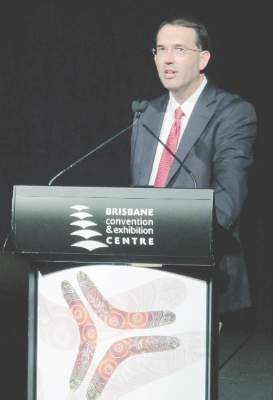User login
BRISBANE, AUSTRALIA – Azithromycin and doxycycline have been shown to still be highly effective treatments for urogenital chlamydia in a randomized clinical trial conducted in a youth correctional facility.*
The study, presented at the World STI & HIV Congress 2015, found a 7-day, twice-daily regimen of 100 mg of doxycycline achieved a 100% cure rate, compared with a 96.8% success rate with a single 1-g dose of azithromycin.
However, noninferiority of azithromycin to doxycycline was not established, said Dr. William Geisler of the division of infectious diseases at the University of Alabama at Birmingham.
“I think the big finding from the study was that both drugs still work quite well, and I think it puts to rest a lot of the concerns about azithromycin for urogenital chlamydia,” said Dr. Geisler.
The study enrolled 310 males and nonpregnant females (median age 17 years) who tested positive for chlamydia when screened upon arrival at the correctional facility.
They were then randomized to receive either doxycycline or azithromycin, and followed up with chlamydia testing 28 days after treatment, which included genotyping to distinguish between treatment failure and infection with a new chlamydia strain.
Of the five treatment failures, four were males and one female; the researchers noted that painful urination occurred more often in azithromycin-treated males who failed treatment versus those cured, although the difference was not statistically significant.
Commenting on this finding, a member of the audience asked whether Dr. Geisler would therefore reconsider treating a symptomatic man with azithromycin.
Dr. Geisler said that while he did have concerns about the efficacy of azithromycin in symptomatic men, adherence also was a factor to be taken into consideration.
“In general, most of the males I see, I don’t feel that great about their likelihood for full adherence [with doxycycline], so I would still feel very comfortable about giving azithromycin to a symptomatic male,” he said.
About three-quarters of the males who were positive for chlamydia at randomization were asymptomatic, compared with nearly 40% of the females.
Adherence was a nonissue for azithromycin, because the single dose could be taken under observation, Dr. Geisler noted. There were greater variations in adherence with the doxycycline, with participants taking between 11 and 16 doses, although about 80% took the prescribed 14 doses.
The study was conducted in correctional facilities in an attempt to limit the possibility of reinfection, and to help improve the likelihood of adherence – both issues that have plagued previous studies.
“These residents, once they get in the facilities, are not typically re-exposed to the untreated partner who’s outside of the facility, so whatever exposures they would have would be new partners in the facility,” Dr. Geisler said at the conference. “The facility that we used for this study, there were really minimal opportunities for re-exposure to chlamydia because everybody who entered the facility got routinely screened and treated for chlamydia.”
While it was challenging to get approval to conduct the study in the correctional facility, Dr. Geisler said it was worth considering.
“Maybe this will pave the way for other studies in these facilities, ones that have low-risk type of procedures [because] controlling for sex is a lot easier in these settings,” he said in an interview.
The National Institutes of Health funded the study. There were no conflicts of interest declared.
*Correction, 11/3/2015: An earlier version of this story incorrectly stated the study's major finding. Although the cure rates were high for both treatments, noninferiority of azithromycin to doxycycline was not established in the study.
BRISBANE, AUSTRALIA – Azithromycin and doxycycline have been shown to still be highly effective treatments for urogenital chlamydia in a randomized clinical trial conducted in a youth correctional facility.*
The study, presented at the World STI & HIV Congress 2015, found a 7-day, twice-daily regimen of 100 mg of doxycycline achieved a 100% cure rate, compared with a 96.8% success rate with a single 1-g dose of azithromycin.
However, noninferiority of azithromycin to doxycycline was not established, said Dr. William Geisler of the division of infectious diseases at the University of Alabama at Birmingham.
“I think the big finding from the study was that both drugs still work quite well, and I think it puts to rest a lot of the concerns about azithromycin for urogenital chlamydia,” said Dr. Geisler.
The study enrolled 310 males and nonpregnant females (median age 17 years) who tested positive for chlamydia when screened upon arrival at the correctional facility.
They were then randomized to receive either doxycycline or azithromycin, and followed up with chlamydia testing 28 days after treatment, which included genotyping to distinguish between treatment failure and infection with a new chlamydia strain.
Of the five treatment failures, four were males and one female; the researchers noted that painful urination occurred more often in azithromycin-treated males who failed treatment versus those cured, although the difference was not statistically significant.
Commenting on this finding, a member of the audience asked whether Dr. Geisler would therefore reconsider treating a symptomatic man with azithromycin.
Dr. Geisler said that while he did have concerns about the efficacy of azithromycin in symptomatic men, adherence also was a factor to be taken into consideration.
“In general, most of the males I see, I don’t feel that great about their likelihood for full adherence [with doxycycline], so I would still feel very comfortable about giving azithromycin to a symptomatic male,” he said.
About three-quarters of the males who were positive for chlamydia at randomization were asymptomatic, compared with nearly 40% of the females.
Adherence was a nonissue for azithromycin, because the single dose could be taken under observation, Dr. Geisler noted. There were greater variations in adherence with the doxycycline, with participants taking between 11 and 16 doses, although about 80% took the prescribed 14 doses.
The study was conducted in correctional facilities in an attempt to limit the possibility of reinfection, and to help improve the likelihood of adherence – both issues that have plagued previous studies.
“These residents, once they get in the facilities, are not typically re-exposed to the untreated partner who’s outside of the facility, so whatever exposures they would have would be new partners in the facility,” Dr. Geisler said at the conference. “The facility that we used for this study, there were really minimal opportunities for re-exposure to chlamydia because everybody who entered the facility got routinely screened and treated for chlamydia.”
While it was challenging to get approval to conduct the study in the correctional facility, Dr. Geisler said it was worth considering.
“Maybe this will pave the way for other studies in these facilities, ones that have low-risk type of procedures [because] controlling for sex is a lot easier in these settings,” he said in an interview.
The National Institutes of Health funded the study. There were no conflicts of interest declared.
*Correction, 11/3/2015: An earlier version of this story incorrectly stated the study's major finding. Although the cure rates were high for both treatments, noninferiority of azithromycin to doxycycline was not established in the study.
BRISBANE, AUSTRALIA – Azithromycin and doxycycline have been shown to still be highly effective treatments for urogenital chlamydia in a randomized clinical trial conducted in a youth correctional facility.*
The study, presented at the World STI & HIV Congress 2015, found a 7-day, twice-daily regimen of 100 mg of doxycycline achieved a 100% cure rate, compared with a 96.8% success rate with a single 1-g dose of azithromycin.
However, noninferiority of azithromycin to doxycycline was not established, said Dr. William Geisler of the division of infectious diseases at the University of Alabama at Birmingham.
“I think the big finding from the study was that both drugs still work quite well, and I think it puts to rest a lot of the concerns about azithromycin for urogenital chlamydia,” said Dr. Geisler.
The study enrolled 310 males and nonpregnant females (median age 17 years) who tested positive for chlamydia when screened upon arrival at the correctional facility.
They were then randomized to receive either doxycycline or azithromycin, and followed up with chlamydia testing 28 days after treatment, which included genotyping to distinguish between treatment failure and infection with a new chlamydia strain.
Of the five treatment failures, four were males and one female; the researchers noted that painful urination occurred more often in azithromycin-treated males who failed treatment versus those cured, although the difference was not statistically significant.
Commenting on this finding, a member of the audience asked whether Dr. Geisler would therefore reconsider treating a symptomatic man with azithromycin.
Dr. Geisler said that while he did have concerns about the efficacy of azithromycin in symptomatic men, adherence also was a factor to be taken into consideration.
“In general, most of the males I see, I don’t feel that great about their likelihood for full adherence [with doxycycline], so I would still feel very comfortable about giving azithromycin to a symptomatic male,” he said.
About three-quarters of the males who were positive for chlamydia at randomization were asymptomatic, compared with nearly 40% of the females.
Adherence was a nonissue for azithromycin, because the single dose could be taken under observation, Dr. Geisler noted. There were greater variations in adherence with the doxycycline, with participants taking between 11 and 16 doses, although about 80% took the prescribed 14 doses.
The study was conducted in correctional facilities in an attempt to limit the possibility of reinfection, and to help improve the likelihood of adherence – both issues that have plagued previous studies.
“These residents, once they get in the facilities, are not typically re-exposed to the untreated partner who’s outside of the facility, so whatever exposures they would have would be new partners in the facility,” Dr. Geisler said at the conference. “The facility that we used for this study, there were really minimal opportunities for re-exposure to chlamydia because everybody who entered the facility got routinely screened and treated for chlamydia.”
While it was challenging to get approval to conduct the study in the correctional facility, Dr. Geisler said it was worth considering.
“Maybe this will pave the way for other studies in these facilities, ones that have low-risk type of procedures [because] controlling for sex is a lot easier in these settings,” he said in an interview.
The National Institutes of Health funded the study. There were no conflicts of interest declared.
*Correction, 11/3/2015: An earlier version of this story incorrectly stated the study's major finding. Although the cure rates were high for both treatments, noninferiority of azithromycin to doxycycline was not established in the study.
FROM THE WORLD STI & HIV CONGRESS 2015
Key clinical point: Azithromycin and doxycycline remain highly effective for the treatment of urogenital chlamydia with cure rates greater than 95%.
Major finding: Azithromycin achieved a 96.8% cure rate for chlamydia, compared with a 100% cure rate with doxycycline. Although the cure rates were high for both treatments, noninferiority of azithromycin to doxycycline was not established in the study.
Data source: Randomized clinical trial of 310 males and females in a youth correctional facility.
Disclosures: The National Institutes of Health funded the study. There were no conflicts of interest declared.

